
Battle Of Point Pleasant -- 1st battle of the American Revolution Historical Marker

Battle Of Point Pleasant -- 1st battle of the American Revolution Historical Marker
During the marches of the Battle of Point Pleasant and Lord Dunmore’s War, George and his brothers fell in love with the lands along the Elk and Kanawha Rivers. They had become successful tobacco farmers and suppliers of salt and coal and for their time were considered rather wealthy men.
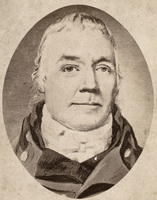
Col. George Clendenin
Courtesy of The National Society of The Colonial Dames of America
George Clendenin bought a tract of land in 1786, but it is not certain when he and his family actually moved into the valley. Up river, the Shawnee Indians were harassing the new white settlers and George set upon building a block-house. The fort was a two-story double-log building, and was considered bullet and arrow-proof. It was small by most standards but soon other out buildings were added and it became known as “Fort Clendenin."

Daniel Boone
One of Fort Clendenin’s early inhabitants was the famous frontiersmen Daniel Boone. He was appointed a Lieutenant Colonel in the Kanawha militia and served under the command of Colonel George Clendenin. He and Col. Clendenin represented Kanawha County in the General Assembly in 1791. Concerned that lands were being lost to Kentucky and Ohio, the Virginia General Assembly approved Clendenin’s request on October 14, 1788, hoping to strengthen its territories in the western part of the state. Daniel Boone was elected to the first of his three terms in the Virginia Assembly before striking out on his crossing the Cumberland Pass with pioneers.
In 1789 The Virginia Assembly chartered the Fort and named it Charles Town in honor of George's father, Charles Clendenin. The town’s name was shortened to Charleston to avoid confusion with two other towns that were also called Charles Town. Charleston is the State Capitol of WV today. (Not to be confused with the small town of Charles Town, WV, which was founded by Charles Washington, brother of George Washington.)

Modern day Charleston, West Virginia
© 2015 Charleston Convention & Visitors Bureau
The original Clendenin Fort stood for over 100 years. There is a stone monument today marking the original location of the Fort.

Fort Clendenin
Written material becomes very scarce for the next few generations of the Clendenin Clan. Charles Clendenin has several children, both sons and daughters. The many branches spread like a willow for the next years. Some of them migrated up the Ohio River and there is a large concentration of Clendenin’s in the North. In “The War of Northern Aggression” Clendenin’s fought for both the North and the South. It is not my intent to flesh out all the hundreds of related ancestors but rather to follow the branch that leads to my second cousins. I will leave it to them to add notes, names and stories of their families.
The next chapter leads us to South Central Tennessee. Waynesboro, Tennessee.
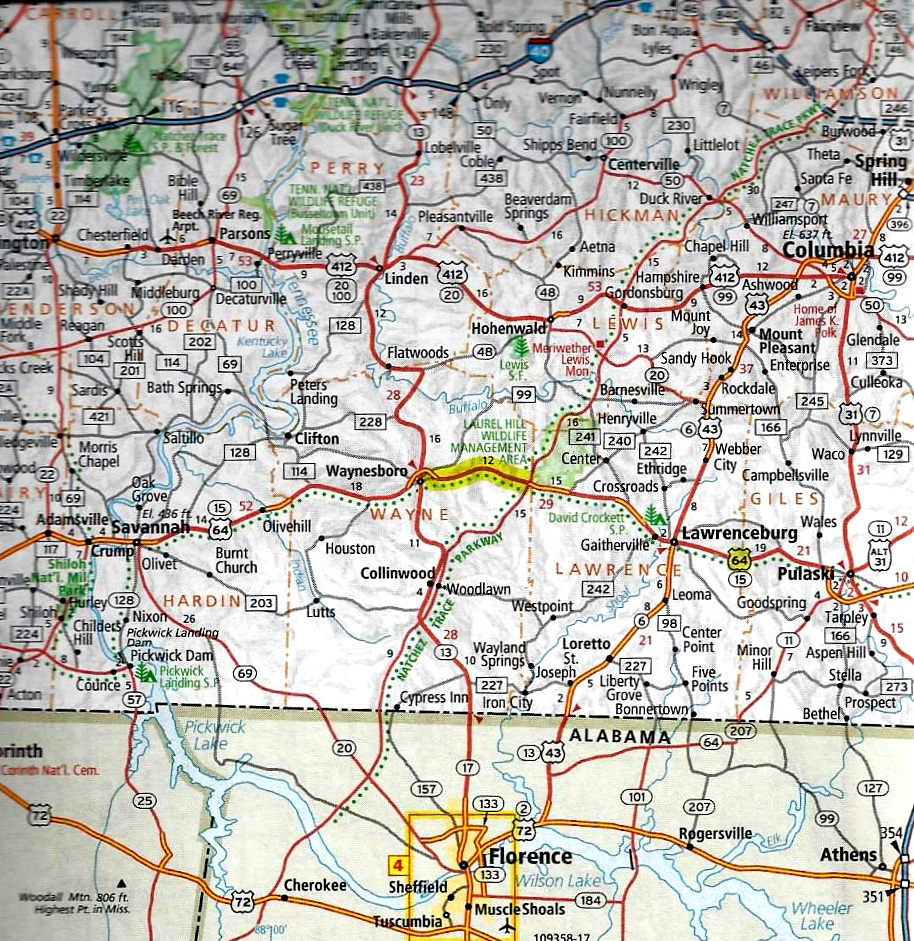
Southern Tennessee Map featuring Waynesboro
THE CIVIL WAR
Most everyone knows the tensions that led to our civil war. Slavery, Abolition, States Rights and pure greed and opportunism. What some may not know is that there were a number of states that wanted to avoid the war completely. This was the case with most of the citizens of Tennessee. Ask anyone which side the State of Tennessee fought for and they will tell you the South. However there were a large number of pacifists in Waynesboro who stayed out of the war until almost the end. Those who did fight found advancement up the ranks rather quickly. It is not surprising that whole regiments from the same towns would become deserters. It is difficult to find Troop Rosters because they changed every day.
In the summer of 1862 Col. Jacob Biffle was sent to Tennessee to recruit a new cavalry regiment, which became the 19th Tennessee Cavalry Regiment. Although the 19th was its official number, the group was known in the field as, mustered as, and paroled as, the 9th Tennessee Cavalry Regiment. Men would fight and die believing themselves members of the 9th Cavalry.
Very little fighting actually took place in Waynesboro but it was crisscrossed many times by both Union and CSA troops. Each time, the town was laid waste of supplies and grain. By the end of the war, Waynesboro was totally decimated. Many people had taken to living in caves to hide and survive. One cave on Ross Creek was called “Indiana” Women and children would say they had gone to “Indiana” in hopes of avoiding detection. This little tidbit may have worked itself into the Clendenin “lingo” when someone would quip, “He’s gone to Gotebo.”

Civil War Reenactment
Courtesy of Sons of the Confederate Veterans - Camp 2678 - Skirmish of Ten Islands, Janney Furnace Ohatchee, AL
One Union officer approaching Waynesboro is reported as having stood in his saddle and could see a green patch of land with trees that had the bark removed as high as one could reach from a horse. He realized the bark was gone from the trees because people were eating it. Thus in the closing days of the war, Wayne County, TN was to experience the trauma of two large armies passing through its territory. Everything that was not tied down or hidden was confiscated by first the Confederate troops, and then the Union troops. The residents were left destitute. As mentioned earlier as was the custom in Scotland, “To the victor go the spoils.”

Civil War Reenactment
Courtesy of Sons of the Confederate Veterans - Camp 2678 - Skirmish of Ten Islands, Janney Furnace Ohatchee, AL
Joseph Armstrong Clendenin was 34 when the war started and lived to be only 52 years. Alvis B. Clendenin was a child of 10 years of age during the war. He died at the age of 88 and buried in Lone Grove, Oklahoma. Our Granddaddy Sam A. Clendenin was born in Wayne Co. TN 23 years after the end of the war. At some time before A.B. died, the Clendenin’s migrated to Southern Indian Territory where Samuel A. Clendenin married Myrtle Cypert on December 18, 1910. A.B. is buried in the Lone Grove Cemetery near his children.
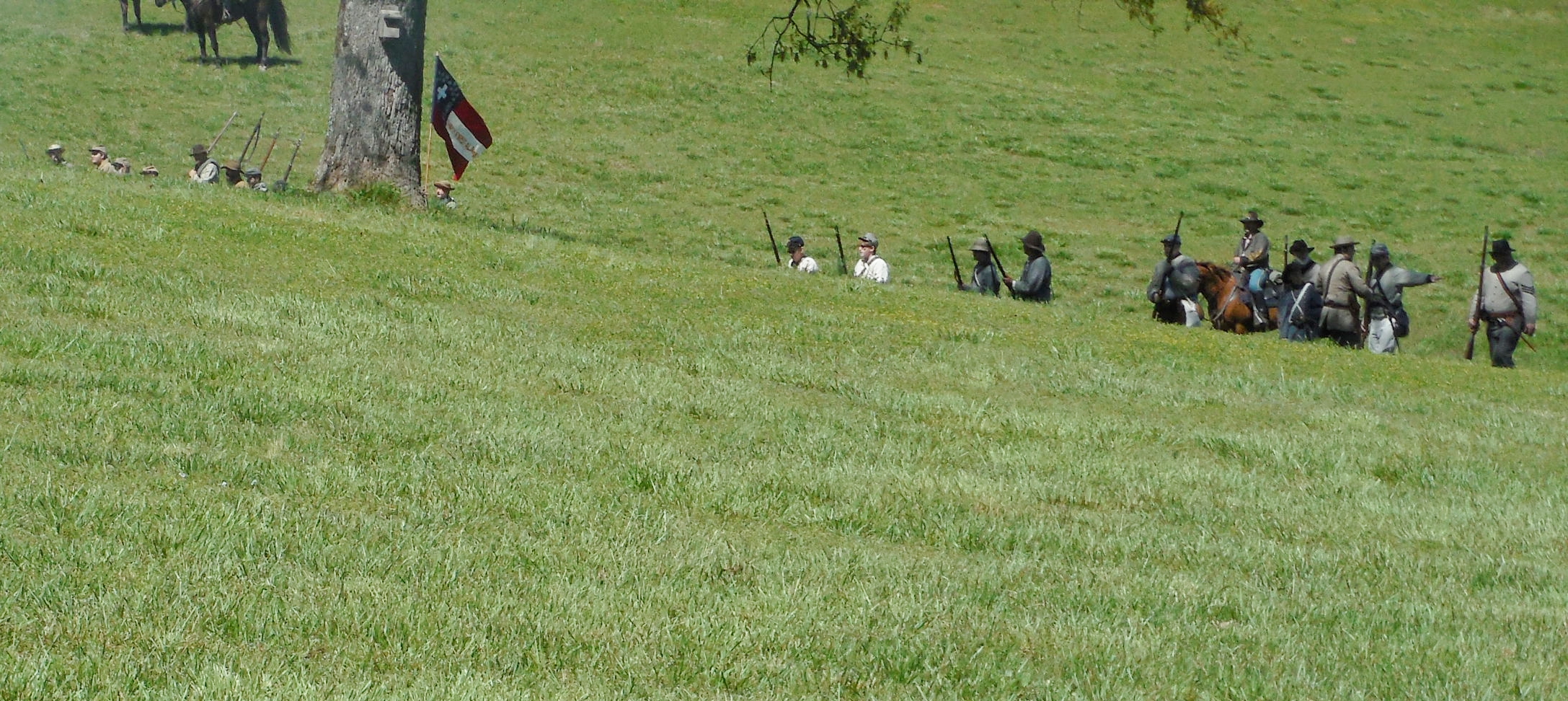
Civil War Reenactment
Courtesy of Sons of the Confederate Veterans - Camp 2678 - Skirmish of Ten Islands, Janney Furnace Ohatchee, AL
Troops were augmented by stealing solders from other units. There is no evidence that points to Alvis and Elizabeth’s son, 1st Lt Joseph Armstrong Clendenin 9th Cavalry, CSA as a deserter. I have heard from many sources that it is highly possible this story is a folk legend. It seems, the story goes, that Joseph Armstrong Clendenin was on a mission to round up fresh horses for the Confederate troops. While on his mission, the war ended. Well, it seemed rather impossible to return the horses back to their rightful owner, so Lt. Clendenin drove them home. As mentioned, the custom in Scotland was “To the victor go the spoils”.
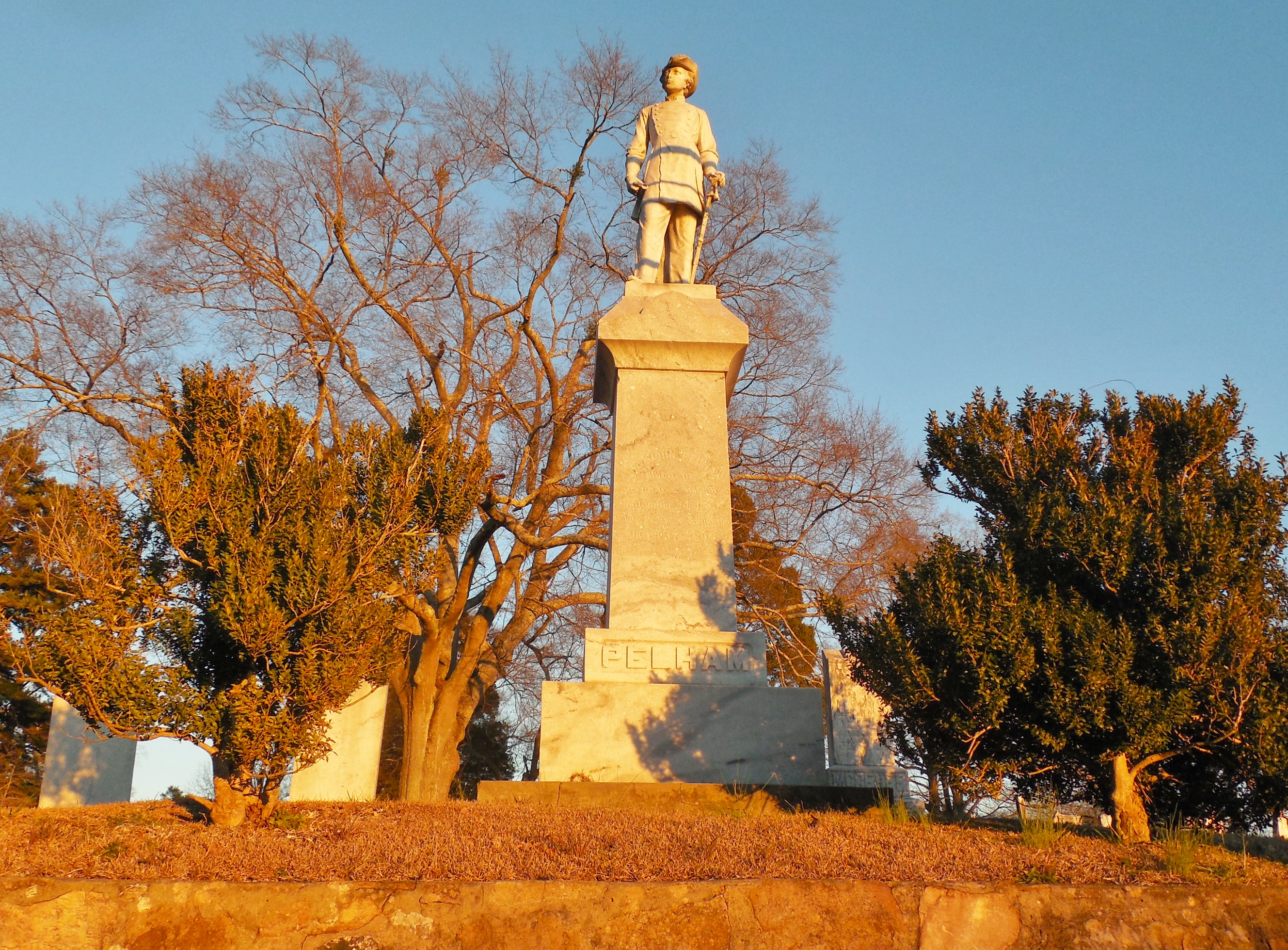
Confederate Cemetery
This part of the story I know to be the truth because I took a trip to Waynesboro and found the cemetery where the Tennessee Clendenin’s are buried. I even have a rubbing of 1st Lt. Joseph Armstrong’s tomb stone and photos of other relatives buried there. While in Wayne Co. I was asking around town if anyone knew where the Cemetery was. One drug store owner told me I should look up Mr. So & So because he had lots of stories he could tell me about “The Old Man.” I was too journey weary and just did not have the time to hunt him down and I have regretted it ever since.
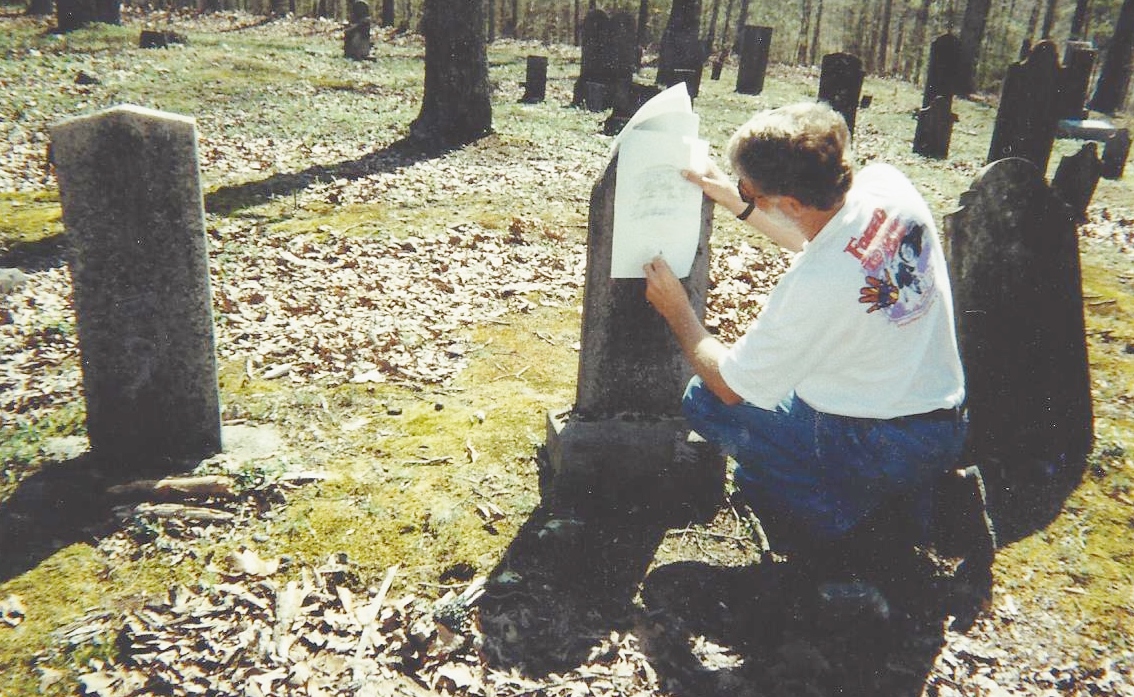


Grave Stone Rubbing -- J. A. Clendenin
I also remember a story my father used to tell about Alvis Clendenin. He traveled cross country from middle Tennessee all the way to Texas. He found some land near what is downtown Dallas. He reportedly “Kicked a can” all the way back to Tennessee because they were asking 25 cents an acre. Damn it! We could have all become J.R. Ewing.
Alvis B. Clendenin was obviously not a quitter. In those days in Indian Territory there were only two ways to get there. Eastern Indian Territory was called “The Impenetrable Forest." The only way in was northwest around Little Rock or southeast through Texarkana. A.B. loaded the family and headed west. He and other Pioneer Whites would become what were known as “Intruders.” While I relish the accusation, the Indians and especially the Choctaw Nation did not. The Trail of Tears was still wet and white encroachment was not welcome.
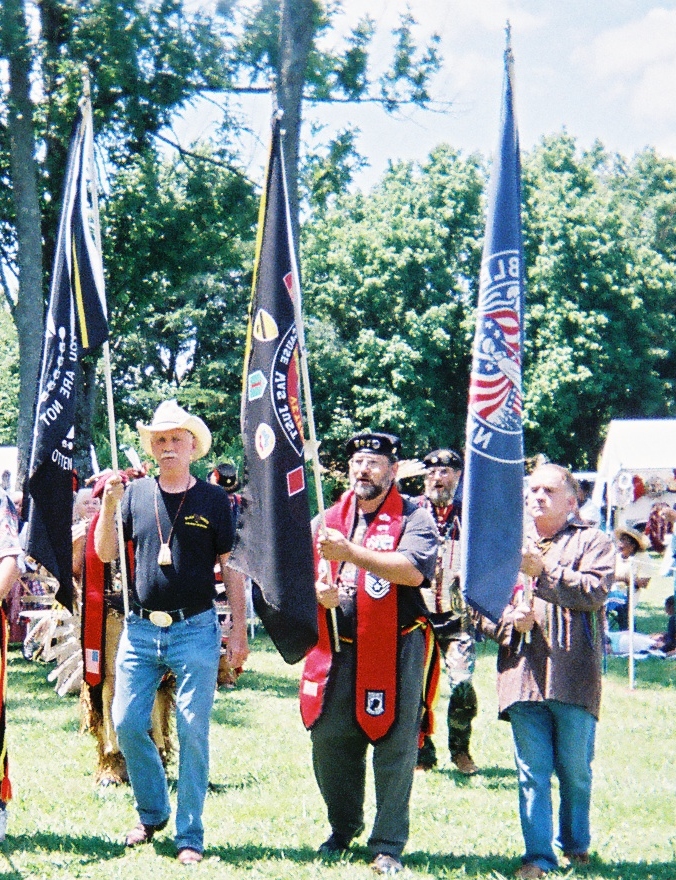
Warrior's Society Grand entry at Pow Wow
INTRUDER
The term intruder applied to unlawful settlers on the lands of the Cherokee, Choctaw, Creek, Chickasaw, and Seminole in Indian Territory -- present eastern Oklahoma. The concept of intrusion first appeared in the 1785 treaty with Cherokees in South Carolina. Federal documents stipulated that unwanted settlers on Cherokee lands would forfeit government protection. The term intruder also appeared as early as 1804 under a treaty with the Sac and Fox tribes that gave the U.S. government responsibility for removing intruders. Encroachment of whites onto Indian lands occurred continuously across the United States during the eighteenth and nineteenth centuries.
Subsequent treaties, acts of Congress, and presidential proclamations, both before and after removal of the Southeastern tribes to land west of the Mississippi River, addressed the intruder problem. Tribes attempted to deal with intrusion by passing laws of their own, negotiating with U.S. officials, and working with one another. The tribes' earlier desire for whites to settle on Indian lands encouraged white-Indian intermarriage and complicated the United States' response and the Indians' predicament. Non-Indians overflowed Indian Territory, despite sporadic attempts by the government to protect Indians from white influence, especially drunkenness.
Settlers, dissatisfied with tribal administration, clamored for a territorial or state government. White agitation led to allotment of communal tribal lands and eventually to statehood.
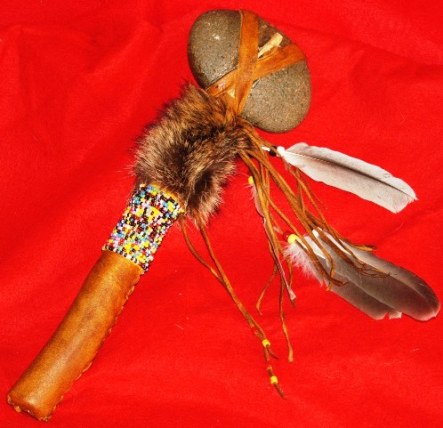
Shawnee War Club
The exact number of early intruders in Indian Territory is unknown. However, available statistics show an explosion in the intruder population between the last decade of the nineteenth century and statehood. In 1890 approximately 70 percent of the population were intruders; by 1907 intruders numbered 90 percent. {Source: Richard Mize}
Nonetheless A.B. and his young family homesteaded near Newport, OK some 8 miles NNW of Ardmore, OK. I have never heard how many acres they initially farmed but it was here that Sam A. Clendenin Sr. and Myrtle Cypert (our grandparents) began their family. Just a few miles south down a section line road, Sam Clendenin's brothers Joe and Ed and sister Ginny lived and farmed. Uncle Joe was a circuit-riding school teacher and rode horse-back to surrounding one-room schools. Uncle Ed was confined to a wheel chair by the time I remember him. I heard him say once, “I’m too weak in my legs to stand up, but I can push myself up with my arms and touch the ceiling.” Uncle Ed also played the Fiddle. The old worn out fiddle is still in the family in the care of Cousin Bruce Clendenin.

Ed Clendenin's Fiddle
Three other lasting memories of their farm was Uncle Joe teaching us to make corn-cob yard-darts by sticking a wad of chicken feathers into one end. That alone kept us out of the house and not under foot. The second memory was drinking cold well water from the gourd dipper that hung on the corner post of the porch. The third memory has two parts. On the fence that ran along the road near the gate to the farm hung a metal sign that simply read, “I’m For Al and Joe.”

I'm For Al and Joe
It was a political campaign for the 1928 presidential election for Al Smith and Joe Robinson. All of the cousins will remember that it was later removed from the fence at the farm and hung in Granddaddy’s carport. Years after Granddaddy died, I mentioned the old sign to Uncle Sambo. Without saying a word, Sambo got up from his chair and pulled the old sign down from the closet. “It’s yours,” he said, “take good care of it.” I have it hanging on the wall in what I call my Man Cave & Museum next to Cousin Lee Anthony’s pencil sketch of “The Clendenin Oak” at the old home place. The sign was to have one more glorious moment of fame. During the Presidential campaign of Al Gore and Joe Lieberman it struck me, AL & JOE !!. Our local newspaper, The Anniston Star, did a feature story on the sign and its travels. I pointed out the great respect citizens of Carter County had in the silent witness that it was the only sign in the county that was not riddled with bullet holes. All other signs were great for shooting practice.
Oh and, speaking of shooting, the old house at Newport had one of the rare outcroppings of Barite in Carter County. Barite is, minerally speaking, a close relative to Rose Rocks. The primary outcrop of Rose Rocks runs from near Gene Autry north to Wynnewood, OK.


Sling Shots in a Circle -- Glass Rocks From Newport
Our Dad’s called them “Glass-Rocks” and used them as ammo for their…..for their…….for their……..damn it, for their “Nigger Shooters.”
(DISCLAIMER: Today this expression is politically and disrespectfully incorrect. I use it here as historical verbiage and never use that word. And I won't even broach the subject of Uncle Sam Jr's nickname . . . )
Well, right here it seems appropriate to trace the delicate and arduous task of tracing our Genealogical line from Col George Clendenin all the way up to our 2nd cousins.